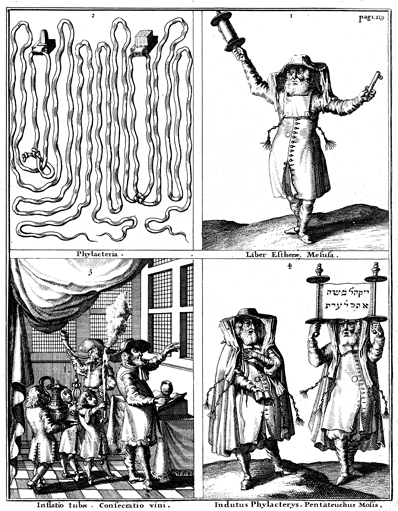Jewish Objects and Ritual Uses
Author: Leusden, Johannes, 1624-1699.
Image Title: Jewish Objects and Ritual Uses
Scripture Reference:
- Deuteronomy 6 (further images / scripture text)
- Joel 2 (further images / scripture text)
- Proverbs 31 (further images / scripture text)
Description: Four registers illustrate various Jewish devices and their ritual uses. Register 1 in the top right-hand corner reads LIBER ESTHERAE, MEZUZA, which translates to “The book of Esther, Mezuzah.” In the illustration, a man in Jewish garments raises a MEZUZAH in his right hand and holds an affixing tool in his left. A mezuzah, the Hebrew word for “doorpost,” is a piece of parchment, or in this case vellum, inscribed with specific passages from the Torah and affixed to the doorframe of Jewish homes to fulfill the Biblical commandment or MITZVAH in Deuteronomy 6:9. While rabbinic MEZUZOT typically contain the Jewish prayer, SHEMA YISRAEL, this mezuzah contains passages from the book of Esther, suggesting its use in Purim festivities. The inscribed parchment or skin is rolled up and housed in a decorative case. Register 2 in the top left-hand corner captioned PHYLACTERIA depicts phylacteries or TEFILLIN, small leather boxes that contain Hebrew texts on vellum worn by Jewish men at morning prayer as a reminder to keep the law mandated in Exodus 13:9-16 and Deuteronomy 6:8-18. One phylactery is fastened with straps on the arm (SHEL YAD or SHELZEROA) and the other is worn on the head (SHEL ROSH). Two symbolic knots, one looped to represent the letter and one in the shape of the letter , are tied in the straps. On the bottom left corner in the third register is an illustration with the caption INFLATIO TUBAE, “the blowing of the horn” and CONSECRATIO VINI, “the consecration of the wine,” referring to the instructions in Joel 2:15-19. The instrument refers to the trumpet blown in Zion, which signals or assembles the people for a solemn fast or public worship. In a windowed room partitioned by a drawn curtain, one man recites the KIDDUSH blessing over a KIDDUSH (sanctification) cup while another sounds a ram’s horn (SHOFAR). Three small children bear an ornate ritual or serving vessel, a torch, and another ritual object. Register 4 is captioned INDUTUS PHYLACTERYS, “clothed in phylacteries,” and PENTATEUCHUS MOSIS, “the Pentateuch of Moses.” On the left, a man in Jewish garments wears a SHEL YAD or SHELZEROA, the phylactery that attaches to the arm. On the right, a man holds up a scroll with the Hebrew equivalent of “Moses Assembled” and other unidentifiable Hebrew phrases which possibly refer to Proverbs 31:25, which reads “She is clothed with strength and dignity.” In Haggadot, “strength” is the Hebrew equivalent to “phylacteries” .
Click here for additional images available from this book.
Request a high-resolution file (fees apply)
Rights Statement: The online edition of this work in the public domain, i.e., not protected by copyright, has been produced by Pitts Theology Library, Emory University.
Rights Status: No Copyright - United States
Pitts Theology Library provides copyright information as a courtesy and makes no representation about copyright or other legal status of materials in the Digital Image Archive.

